|
Historic Sites of the U.S.-Mexican War
M E X I C O
PLEASE NOTE: Information regarding sites was collected from a variety of sources. Addresses, telephone numbers, hours of operation and admission costs may not be accurate. Would-be visitors are advised to call or write, in advance of their proposed visit, for the most up-to-date information.
It should be also noted that this list includes museums that may not actually be historic sites but house relics and artifacts pertaining to the U.S.-Mexican War.
TAMAULIPAS
Matamoros
Museo Casa Mata
This museum is housed in a small fort that took part in the 1846 bombardment of Fort Texas (later Fort Brown). Address: Corner of Guatemala and Santos Degollado, H. Matamoros, Tamps., Mexico. Telephone: 881-13-5929. Admission fee.
Tampico
|
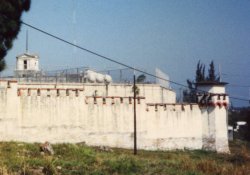
Photo by Bill Bozic.
|
Fort Andonega (Fuerte de Andonega).
During the U.S. occupation of Tampico, 1847-1848, this old Spanish fort was a much-visited landmark by American soldiers who were camped in its vicinity. It is presently being used as a prison and may not be visted.
|
[Return to TOP]
NUEVO LEON
Monterrey
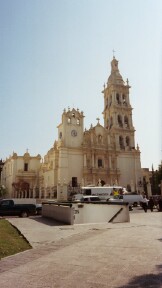
Cathedral La Inmaculada Concepcion.
Photo courtesy Bill Bozic. Used with permission.
Museo de Historia de Nuevo Leon.
Housed in former Palacio Municipal. Built 1853. Exhibits illustrate history of State of Nuevo Leon.
Located on the Plaza Zaragoza, opposite the cathedral. Open Tue.-Sun. 10 a.m. - 6 p.m. Admission fee.
|
Cathedral La Inmaculada Concepcion.
Used to store gunpowder during siege of September 1846. Suffered damage as the last stronghold of the Mexican defenders of Monterrey. Located on the Plaza Zaragoza in downtown Monterrey. Free admission.
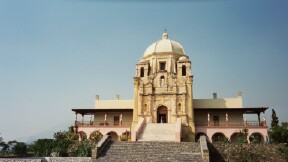
Obispado ("Bishop's Palace")
Photo courtesy Bill Bozic. Used with permission.
Obispado ("Bishop's Palace")/Museo Regional de Nuevo Leon.
Built 1787-90. On September 22, 1846 U.S. forces under General Zachary Taylor stormed up the steep hill (the Cerro del Obispado or Cerro del Chepe Vera) on which the "Bishop's Palace" stands. They overwhelmed the Mexican garrison at the top and seized the "palace." From here, visitors can enjoy a magnificent view of Monterey and neighboring Federacion Hill, which the Americans also assaulted and took.
Address: Calle Rafael José Verger, Colonia Obispado, C. P. 64010, Monterrey, Nuevo Leon, Mexico. Telephone: 528-346-0404. Open Tue.- Sat., 10 a.m. - 1 p.m., Sun. 10 a.m. to 5 p.m. Admission fee.
|
|
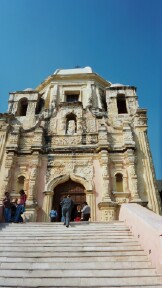
Obispado (Bishop's Palace)
Photo courtesy Bill Bozic. Used with permission.
|
Obispado description by DMWV President Bill Bozic:
"The Obispado (Bishop's Palace) has a newly renovated museum which gives excellent coverage to the Spanish Era, Independence, French occupation in the 1860's, and Mexican Revolution, but totally omits any hint at the battle fought here, nor American occupation! Visitors would be advised not to mention the US Occupation."
"In a small area, under the stairs, there is a gift shop. Nothing for sale related to the US-Mexican War and quite a limited selection of items for sale."
"From the grounds of the Obispado, there is a great view of Monterrey and a visitor can easily surmise the importance of the site as well as the difficulty in taking such a position."
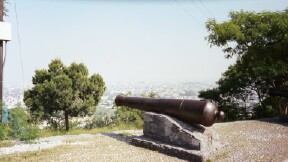
Obispado Cannon
Photo courtesy Bill Bozic. Used with permission.
|
Below: Present-day Monterrey is a very modern city. These street scenes, which show the Ave. Morelos (formerly Calle Principal) were taken in the small "pueblo viejo" or "old town" section of Monterrey, away from the tall, modern, office buildings. This area is only a few blocks large and is adjacent to the cathedral.
|
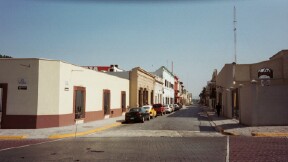
Photo courtesy Bill Bozic. Used with permission.
|
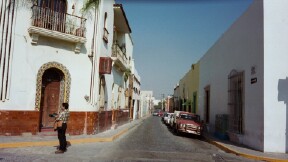
Photo courtesy Bill Bozic. Used with permission.
|
[Return to TOP]
COAHUILA
Near Saltillo
|
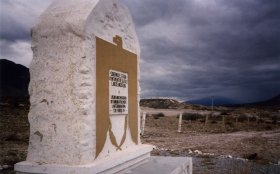
Photo by Bill Bozic. Used with permission.
|
Buena Vista (La Angostura) Battlefield.
A marble monument is located alongside the highway that runs through this site. It commemorates the battle which took place here February 22-23, 1847 between the forces of General Zachary Taylor and General Antonio Lopez de Santa Anna. The Battle of Buena Vista or La Angostura ("the Narrows") was the bloodiest of the war. Taylor's victory turned him into a national hero. The battlefield is located about seven miles south of Saltillo on Highway 54 going toward Zacatecas. Apart from some development on its fringes, Buena Vista looks much the same as it did in 1847.
|
Saltillo
|
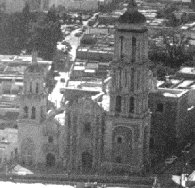
Photo by ?.
|
Cathedral of Santiago.
This magnificent Roman Catholic cathedral is located on the Calle Hidalgo, opposite the Palacio Municipal on the Plaza de la Independencia. This structure was used as an American hospital following the Battle of Buena Vista. Free admission.
|
[Return to TOP]
CHIHUAHUA CITY
Near Chihuahua City
Sacramento Battlefield.
It was here, on February 28, 1847 that a thousand Missouri volunteers led by Col. Alexander Doniphan battled an army of more than 4,000 Mexican troops commanded by General Pedro Garcia Condé. Although the Mexicans held the high ground with more than 20 pieces of artillery, the Missourians won. The battlefield is located between markers 30 and 28, going south on Highway 45.
[Return to TOP]
VERACRUZ
Veracruz
Fuerte de San Juan de Ulua.
Located on a rocky shoal in the harbor, the 135 guns of this huge old Spanish fortress helped defend the city during the U.S. siege of March 9-29, 1847. Presently maintained by the Mexican navy, San Juan de Ulua now houses an exhibit tracing its long history, although there is little emphasis on the Mexican War. Most of the exhibits focus on the Spanish treasure fleets and the Mexican Revolution of 1910. The fort is accessible by a causeway from the port area of the city. Open daily 9 a.m. - 5 p.m. Admission fee. |
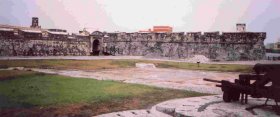
Photo by Bill Bozic. Used with permission.
|
|
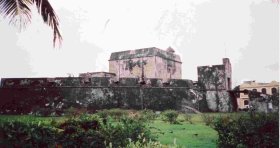
Photo by Bill Bozic. Used with permission.
|
Baluarte de Santiago.
Built 1635. The last remaining vestige of the old stone walls, constructed by the Spanish, which once surrounded the city of Vera Cruz. This battlement, located at 16 de Septiembre and Reyon, withstood a pounding by U.S. artillery. It now houses a small museum which is open daily from 10 a.m. to 7 p.m. Admission fee. |
|
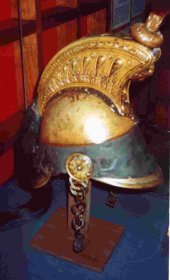
Photo by Bill Bozic. Used with permission.
|
One of the principal attractions of the Baluarte de Santiago is some recently discovered Aztec gold. However, if if you walk behind the building, there is a one-room museum of the Intervention. Artifacts dating from the Mexican War and the U.S. occupation during the Mexican Revolution are here. They include the Mexican cavalry helmet seen left. Exhibits are in the Spanish language only but some very informative, well-written English language brochures are available for purchase, upon request, at the ticket booth.
|
Church of San Francisco.
Built 1775, restored 1983-84. This structure was once part of a Franciscan convent used as a hospital by the American army during the 1847-1848 occupation of Vera Cruz. Now houses a small museum, Santuario de la Reforma. Located in the port area, near the Plaza de la Reforma. Collado Beach.
Located on the south side of Vera Cruz, this is where 10,000 U.S. troops led by General Winfield Scott were put ashore in an unprecedented mass amphibious landing on March 9, 1847.
Near Jalapa
National Bridge (Puente Nacional)
U.S. troops and wagon trains crossed this bridge innumerable times on their to and from the interior of Mexico. The graves of many U.S. soldiers, long forgotten and abandoned, are located in the vicinity of the bridge. Cerro Gordo Battlefield.
This battlefield is characterized by tall hills on either side of Highway 140, the old National Highway. It looks much the same today as it did on April 18, 1847 when Scott's army defeated the Mexican troops, commanded by Santa Anna, who defended this position. Apart from a small monument on Cerro Gordo, or Telegraph Hill, commemorating General Vasquez, the privately-owned battlefield is unmarked. The site is located about 60 miles west of Vera Cruz and 15 miles east of the city of Jalapa, which was occupied by U.S. forces shortly after the battle.
|
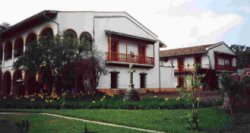
Photo by Bill Bozic. Used with permission
|
El Encero (Santa Anna's hacienda)
This old hacienda, which is now a museum open to the public, was one of three country homes that Santa Anna maintained during his presidency. (There were two others closer to Vera Cruz city). This one has a particularly long history, being founded in the 16th century by a Spaniard named Encero. During the Mexican War U.S. trooped camped nearby. The site offers a nice resturant and small tourist shop. Entrance to the house is by guided tour. No English is spoken.
|
Perote
Perote Castle (Castillo de Perote).
This old structure, built by the Spanish, was used by both the Spanish and Mexican governments as a prison. Among its more illustrious occupants were the Texians captured during the ill-fated Texian-Santa Fe Expedition of 1843. During the U.S. occupation, 1847-1848, it was used as a hospital. As a result, the area surrounding the moat is littered with the forgotten graves of hundreds, perhaps thousands of U.S. soldiers. The castle is presently being used as a prison. No admission permitted.
[Return to TOP]
PUEBLA
Puebla
Church of Guadalupe.
U.S. forces commanded by Col. Thomas Childs were concentrated here during the siege by Santa Anna's troops, which followed the occupation of Mexico City in September. The church is located on Avenida 8 Norte, on the outskirts of Puebla. Fort Loreto.
U.S. troops also held this position during the 21-day siege which was lifted on October 12, 1847. It is also located on Avenida 8 Norte. The old fort presently houses a museum.
[Return to TOP]
DISTRITO FEDERALE (Mexico City)
|
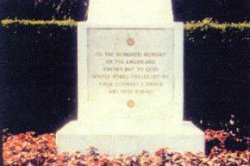
Photo by Ruben Arvizu.
|
|
Chapultepec Castle(Castillo de Chapultepec).
On September 13, 1847 U.S. troops led by General Winfield Scott fought their way up a tall hill in what is now the Bosque de Chapultepec, or Chapultepec Park, atop which stood this magnificent structure. At that time, the castle was a Mexican military school. It now houses the National Museum of History. Telephone: 553-6202. Open Tue. - Sun. 9:30 a.m. - 6 p.m. Admission fee. Los Niños Heroes Monument.
This grand, imposing monument, at the base of the hill on which Chapultepec Castles stands, is a memorial to the cadets who took part in the defense of Chapultepec during the 1847 battle. El Molino del Rey Battlefield.
The Molino del Rey or "King's Mill" after which this battle was named no longer stands. The site of the battle, indistinguishable from any other part of Chapultepec Park, lies about a half-mile west of the hill on which the castle stands. Historic markers tell the story of the battle. Presidential Palace (Palacio Nacional).
Located on the Plaza de la Constituction or "Zocalo," in the heart of Mexico City, this building is the famed "Halls of the Montezumas" over which U.S. Marines raised the Stars and Stripes on September 14, 1847. During the 1847-1848 occupation of the Mexican capital, General Winfield Scott had his headquarters here. Today it houses the offices of the President of Mexico, as it did before the occupation and since. Open Tue. - Sat. 9 a.m. - 5 p.m. Churubusco Convent/Museum of the Interventions (Museo Nacional de las Intervenciones).
One of the hardest-fought battles of the U.S.-Mexican War took place here on August 20, 1847 when Scott's troops assaulted this heavily-fortified Franciscan convent used by Santa Anna's troops as a fort. The Americans won but both sides sustained large losses. Today it houses a museum, with exhibits relating to the war. Located at Xicotencatl and 20 de Agosto in the suburb of Coyoacan, just south of Mexico City. Telephone: (5) 604-0699 or (5) 688-7926. Open Tue. - Sun. 9 a.m. - 6 p.m. Admission fee.
San Patricio Battalion Commemorative Plaque.
A marble plaque is located at No. 24 San Jacinto in the Mexico City suburb of San Angel. It honors the infamous San Patricio Battalion, deserters from the U.S. Army who fought for Mexico during the U.S.-Mexican War. Every year, on September 12, a commemorative ceremony is held at the Plaza of San Jacinto to honor the San Patricios, many of whom were Irish - hence the name San Patricio (Saint Patrick).
|
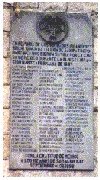
Photo by Beverly Tillman.
|
[Return to TOP]
Return to: [Historic Sites of the U.S.-Mexican War]
|